 Farmers need to act now to take advantage of five-year averaging and potentially reduce their income tax bills, according to rural accountant Old Mill.
Farmers need to act now to take advantage of five-year averaging and potentially reduce their income tax bills, according to rural accountant Old Mill.
Introduced for the current year, five-year averaging enables farmers to spread their income and expenditure over five years, to iron out the peaks and troughs caused by market volatility. “Cash is very tight on a lot of farms right now but if you go back five years there is likely to have been a lot of tax paid,” says chairman of the board, Mike Butler. “The critical point for all farmers who operate as a sole traders and partnerships is that 2016/17 is the first year in which they can use this tool to potentially secure a tax refund.”
So how does it work? “In essence, if you anticipate making very little profit or a loss this year, you can spread that back to offset against profits in previous years,” explains Mr Butler. “The larger the financial downturn the greater the benefit of averaging.”
Where farmers have previously enjoyed particularly large profits – especially those taxed at the higher rate – it may be worth looking at the timing of expenditure and sales in the current tax year to further reduce taxable profits or maximise losses. “While it’s never worth making business decisions simply to reduce tax, if you are planning investment in the farm you might as well do it in the most timely and tax-efficient manner.”
Farmers can still choose to average over two years, and in future will be able to continue to use five- or two-year averaging in each financial year to reduce market volatility.
The average has to be calculated for each partner in the business, so what applies to one person may not apply to another. “It can be quite a complicated process, but the advantages are considerable,” explains Mr Butler. “The key is to act before the March year-end: Getting a tax rebate at this critical time will be extremely helpful from a cash flow perspective so don’t miss this valuable opportunity.”
For more information contact Mike Butler on 01749 335019.



